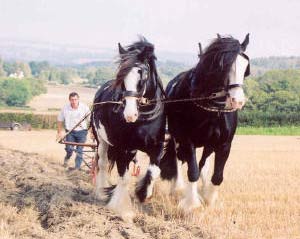Technique of working horses
The average pulling force of horses equals 13-15% of body weight. In a short time traction may be 70-80%.
Depending on the number of working hours, traction, the speed of ration and ration of horse food is reasonably arranged. For working horses, the main energy supply for muscles is starch and fat. Many experiments show that during the first hour of work, 4/5 of the energy that muscles produce is due to starch and one-fifth is due to fat use. But during the sixth working hour, muscles use 1/6 of the energy from starch and 5/6 from fat. So to make the workers maintain their ability to work healthy, supple, it is necessary to have a reasonable diet.
For horses to work normally, maintain their physical condition and health, need to eat a serving of 2-2.2v per 100kg weight, each unit has 60-65g of digestible protein.
Working horses need to eat minerals. Lack of minerals also causes a decrease in horse health and working ability. Symptoms of mineral deficiency are working against fatigue, unsteady walking, swollen joints, and severe fractures.
 For every 100kg, we need to feed 6-8g Ca and 3-5g P. We have to make the horse work to eat salt regularly, every day give the horse 30-35g salt.
For every 100kg, we need to feed 6-8g Ca and 3-5g P. We have to make the horse work to eat salt regularly, every day give the horse 30-35g salt.
So must give the horse mass:
180 200kg eat 10kg of fresh grass and 1.6-1.7kg of concentrate
210-230kg eat 12kg of fresh grass and 1.8, -2.0kg of concentrate
240-270kg eat 13-14kg of fresh grass and 2.1-2.3kg of concentrate
In mixed concentrate, there are 2900 Kcal / kg with 14-15% protein
After eating the horse, rest 1-2 hours.
The most working horse is a horse that is far from tired and should not drink water immediately because it is easy to cause abdominal pain. After taking 15-20 minutes to drink water.
In the winter mountains, the air temperature is often low, it is cold. If the temperature is below 10 ° C, leave the horse to work or if you do, do not let the horse go away.
Pay attention to the selection of saddles that are suitable for the horse's body to prevent the horse from being saddened, causing the foreign trade to become very difficult to use.
- Ambition to create a race of asexual horses
- The wild horse Przewalski echoes the prairie
- Interesting facts about horses
- Small horses like ... cats
- Interesting things of horses
- Wild horses
- Why do horses often sleep?
- The horse's 'sniffing' contains their happy feelings?
- Horses are as smart as dolphins and doves
- Nice: The pre-mating game of horses
- Horses recognize each other through the neigh
- The horse can count
 'Barefoot engineer' invents a pipeless pump
'Barefoot engineer' invents a pipeless pump Process of handling dead pigs due to disease
Process of handling dead pigs due to disease Radiometer
Radiometer Warp Engine: Technology brings us closer to the speed of light
Warp Engine: Technology brings us closer to the speed of light